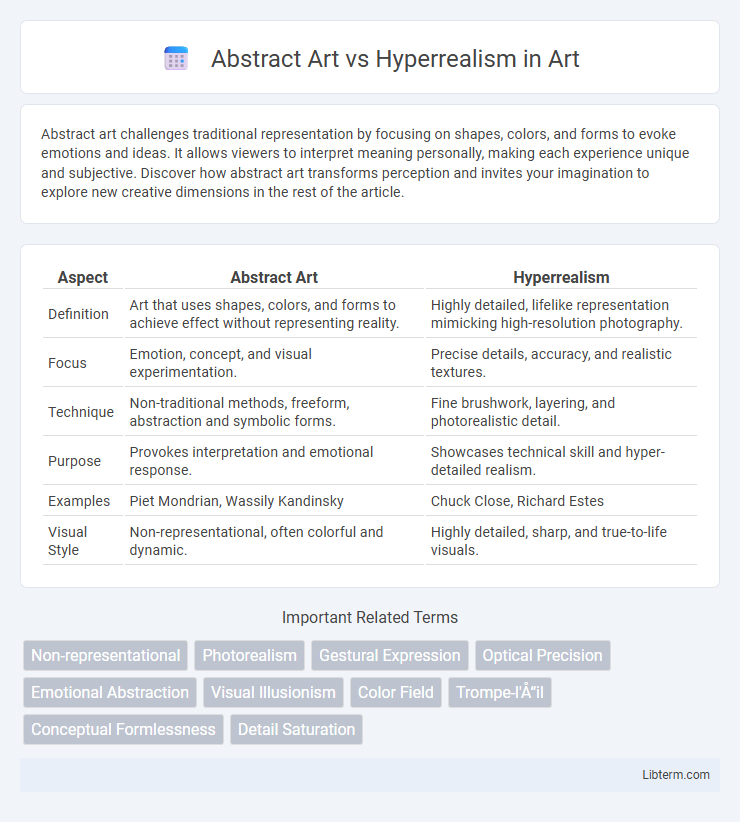Abstract art challenges traditional representation by focusing on shapes, colors, and forms to evoke emotions and ideas. It allows viewers to interpret meaning personally, making each experience unique and subjective. Discover how abstract art transforms perception and invites your imagination to explore new creative dimensions in the rest of the article.
Table of Comparison
| Aspect | Abstract Art | Hyperrealism |
|---|---|---|
| Definition | Art that uses shapes, colors, and forms to achieve effect without representing reality. | Highly detailed, lifelike representation mimicking high-resolution photography. |
| Focus | Emotion, concept, and visual experimentation. | Precise details, accuracy, and realistic textures. |
| Technique | Non-traditional methods, freeform, abstraction and symbolic forms. | Fine brushwork, layering, and photorealistic detail. |
| Purpose | Provokes interpretation and emotional response. | Showcases technical skill and hyper-detailed realism. |
| Examples | Piet Mondrian, Wassily Kandinsky | Chuck Close, Richard Estes |
| Visual Style | Non-representational, often colorful and dynamic. | Highly detailed, sharp, and true-to-life visuals. |
Introduction to Abstract Art and Hyperrealism
Abstract art emphasizes non-representational forms, using shapes, colors, and textures to evoke emotions rather than depicting real-world objects. Hyperrealism focuses on creating extremely detailed and lifelike images that resemble high-resolution photographs, often highlighting minute details and textures. Both movements challenge traditional art by redefining representation and perception through contrasting visual approaches.
Historical Origins and Development
Abstract art originated in the early 20th century, breaking away from traditional representation to emphasize shapes, colors, and forms, with pioneers like Wassily Kandinsky and Piet Mondrian leading its development. Hyperrealism emerged in the late 1960s as an evolution of photorealism, focusing on meticulous detail and lifelike precision that surpasses photographic clarity, with artists such as Chuck Close and Richard Estes shaping the movement. Both styles reflect distinct historical contexts: abstract art responding to modernist ideals and emotional expression, while hyperrealism engages with contemporary media and the technological advances in imaging.
Defining Characteristics of Abstract Art
Abstract art is characterized by the use of shapes, colors, and forms that do not represent objects in the real world, emphasizing emotional expression and conceptual ideas over realistic depiction. It often employs non-representational compositions, bold color schemes, and dynamic brushstrokes to evoke subjective interpretation and convey intangible concepts. Unlike hyperrealism, which aims for photographic precision, abstract art prioritizes visual language that challenges viewers' perceptions and invites personal meaning.
Defining Characteristics of Hyperrealism
Hyperrealism is characterized by its meticulous attention to detail, aiming to create artwork that resembles high-resolution photographs, often emphasizing textures, light reflections, and intricate facial features. Unlike Abstract Art, which prioritizes emotional expression and non-representational forms, Hyperrealism focuses on precise representation, capturing scenes with extraordinary clarity and depth. This style often employs techniques like airbrushing and layering to enhance realism, making everyday subjects appear lifelike and immersive.
Techniques and Mediums Used
Abstract art employs techniques like gestural brushstrokes, color field applications, and layering of mixed media including acrylics, oils, and collage to evoke emotion and conceptual ideas, emphasizing form and color over realistic representation. Hyperrealism relies on precise, meticulous methods such as airbrushing, fine brushes, and photorealistic detailing using mediums like oil paints and graphite to achieve lifelike textures and depth that mimic high-resolution photographs. The contrast between spontaneous abstraction and painstaking replication highlights the divergent approaches to technique and medium characteristic of each art style.
Prominent Artists in Both Movements
Abstract art features prominent artists like Wassily Kandinsky, known for pioneering abstract expressionism, and Piet Mondrian, who developed neoplasticism, emphasizing geometric shapes and primary colors. Hyperrealism is led by artists such as Chuck Close, celebrated for his large-scale, photorealistic portraits, and Ron Mueck, whose sculptures exhibit meticulous detail and lifelike accuracy. Both movements showcase distinct approaches to visual representation, with abstract artists exploring emotional and conceptual depth, while hyperrealists focus on extraordinary precision and realism.
Visual Impact and Viewer Interpretation
Abstract art emphasizes emotional expression through non-representational forms, relying on color, shape, and texture to evoke subjective interpretations and provoke personal reflection. Hyperrealism delivers intricate detail and lifelike precision, creating striking visual impact that challenges viewers' perception of reality and invites admiration for technical skill. Viewer interpretation in abstract art varies widely due to its open-ended nature, whereas hyperrealism prompts focused attention on realism and narrative clarity.
Cultural and Philosophical Influences
Abstract art challenges traditional representation by emphasizing emotional expression and subjective experience, rooted in early 20th-century modernist movements influenced by existentialism and psychoanalysis. Hyperrealism, emerging in the late 20th century, reflects a cultural fascination with visual precision and reality, often questioning the nature of perception and the boundary between reality and illusion. Both styles embody philosophical dialogues on human experience, with abstract art exploring inner consciousness and hyperrealism engaging with external reality and technological advancements.
Contemporary Trends and Innovations
Contemporary trends in abstract art emphasize dynamic textures, bold color palettes, and digital manipulation, reflecting emotional depth and conceptual exploration beyond traditional forms. Hyperrealism advances through innovations in high-resolution techniques, photorealistic 3D rendering, and mixed media integration, pushing boundaries of visual accuracy and immersive experience. Both styles increasingly incorporate technology and interdisciplinary approaches, reshaping artistic expression in the digital age.
Abstract Art vs Hyperrealism: Which Resonates Today?
Abstract art emphasizes emotional expression and conceptual depth through non-representational forms, appealing to viewers seeking interpretive freedom. Hyperrealism, characterized by its meticulous detail and lifelike precision, captivates audiences with its technical mastery and visual accuracy. The resonance today depends on individual preferences for imaginative exploration versus realistic representation, reflecting diverse responses to contemporary artistic experiences.
Abstract Art Infographic

 libterm.com
libterm.com